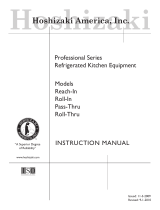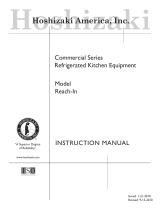
3
CONTENTS
I. Installation Instructions ....................................................................................................... 5
A. Location ........................................................................................................................ 5
B. Checks Before Installation ............................................................................................ 5
C. Setup ............................................................................................................................ 6
1. General .................................................................................................................... 6
. Overow Pan ........................................................................................................... 7
3. Electrically Heated Condensate Pan ....................................................................... 7
4. Food Cart Ramp (Roll In and Roll Thru Units) ........................................................ 8
D. Electrical Connection .................................................................................................... 8
E. How to Open the Front Panel ....................................................................................... 9
F. Door Reversal (except heated glass doors) .................................................................. 9
G. Final Checklist ............................................................................................................ 10
II. Operating Instructions ..................................................................................................... 11
A. Operation ................................................................................................................... 11
B. Startup ........................................................................................................................ 1
C. Cabinet Temperature .................................................................................................. 1
1. TempGuard Models ............................................................................................... 1
a) Temperature Display .......................................................................................... 1
b) Adjusting the Temperature Setpoint ................................................................... 13
c) Changing the Temperature Display Scale (°F or °C) .......................................... 13
. SafeTemp Models ................................................................................................. 13
a) Temperature Display .......................................................................................... 13
b) Temperature Setpoint ......................................................................................... 14
c) Changing the Temperature Display Scale (°F or °C) .......................................... 14
D. Defrost ........................................................................................................................ 14
1. TempGuard Models ............................................................................................... 14
a) For Refrigerators ................................................................................................ 14
b) For Freezers ....................................................................................................... 15
. SafeTemp Models ................................................................................................. 15
a) For Refrigerators ................................................................................................ 15
b) For Freezers ....................................................................................................... 15
E. Food Storage .............................................................................................................. 16
F. Perimeter Frame Heater ............................................................................................. 16
G. Safety Devices ........................................................................................................... 16
1. High Pressure Switch ............................................................................................ 16
. Compressor Short Cycle Timer ............................................................................. 16
a) TempGuard Models ............................................................................................ 16
b) SafeTemp Models .............................................................................................. 16
3. Compressor Protector ........................................................................................... 17
4. Defrost Protection .................................................................................................. 17
IMPORTANT
This manual should be read carefully before the unit is installed and operated.
Only qualied service technicians should install, service, and maintain the unit.
Read the warnings contained in this booklet carefully as they give important
information regarding safety. Please retain this booklet for any further reference
that may be necessary.

























